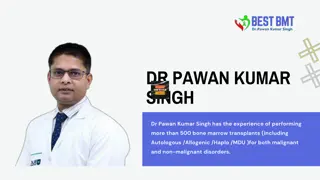The Mysteries of Life: Origins, Evolution, and Plant Cells
The origins of life on Earth, spanning billions of years, continue to intrigue scientists. From the emergence of the Earth to the evolution of plant and animal life forms, the journey of life is a profound tale of adaptation and survival. Explore the fascinating hypothetical views on the origin of life, the evolution of plant cells, and the major components that make up these essential building blocks of the botanical world.
Download Presentation

Please find below an Image/Link to download the presentation.
The content on the website is provided AS IS for your information and personal use only. It may not be sold, licensed, or shared on other websites without obtaining consent from the author. Download presentation by click this link. If you encounter any issues during the download, it is possible that the publisher has removed the file from their server.
E N D
Presentation Transcript
ORIGIN OF LIFE Abhijit Bhattacharjee Asst Professor, Dept of Botany Swami Vivekananda Mahavidyalaya Mohanpur, West Tripura Email id: svm.mnp@gmail.com Website: svmmohanpur.nic.in
Origin of Earth? The earth is said to have come into existence 5 billion years ago and before the existence of life.
What is Life? Life on earth came into existence only a billion years after the existence of earth Life is an urge of the Universe to understand itself Life is a pageant that passes very quickly, going hastily from one darkness to another darkness with only ignes fatui to guide; and there is no sense in it. I learned that, Kerin, without moiling over books (according to James Branch Cabell). There are two major forms of life in earth i.e. plants and animals
Origin of life? It is one of the great mysteries in the Universe The origin of life is a long-standing and controversial topic. During the mid-17thcentury the British physiologist William Harvey, in the course of his studies on the reproduction and development of the king s deer, discovered that every animal comes from an egg (a single cell). The earliest known vascular plants come from the Silurian period. Cooksonia is often regarded as the earliest known fossil of a vascular land plant, and dates from just 425 million years ago in the late Early Silurian.
Hypothetical view of origin... The origin of life is a result of a supernatural event that is, one irretrievably beyond the descriptive powers of physics, chemistry and other science. Life, particularly simple forms, spontaneously and readily arises from nonliving matter in short periods of time, today as in the past. Life is coeternal with matter and has no beginning; life arrived on Earth at the time of Earth s origin or shortly thereafter. Life arose on the early progressive chemical reactions. Such reactions may have been likely or may have required one or more highly improbable chemical events. Earth by a series of
Plant cells plants are mainly multicellular living organ plant cells are eukaryotic type with true nucleus plant cells are differentiated from the cells organisms by their cell walls, chloroplasts, vacuole. specifically, are photo-autotrophic because they use light energy from the sun to produce glucose. of other and central plant cells Source: micro.magnet.fsu.edu
Major components of plant cell cell wall cell membrane Nucleus Plastids Leucoplasts Chloroplasts Central Vacuole Golgi Apparatus Ribosomes Mitochondria Lysosome
Types of plant cells Collenchyma Cells Sclerenchyma Cells Parenchyma Cells Xylem Cells Phloem Cells
Animal cells Animal cells are the basic unit of life in organisms of the kingdom Animalia. They are eukaryotic cells. unlike plants and fungi cells, do not have a cell wall. like all eukaryotic cells, animal cells mitochondria to create ATP. have Source: withcarbon.com
Organelles of animal cell cell membrane nucleus ribosomes endoplasmic reticulum vesicles golgi apparatus mitochondria cytosol lysosome peroxisome Source: biologywise.com
Functions Cells are highly specialized to carry out specific tasks. Provide Structure and Support: every organism is made of cells. Facilitate Growth through Mitosis and give rise to new organisms. Allow Passive and Active Transport Produce Energy Create Metabolic Reactions Aids in Reproduction
Difference between plant and animal cells Basis of comparison Plant cells Animal cells Cell Size Usually larger, which is fixed. Smaller in size and irregular. Cell Shape Rectangular. Round Enclosed by rigid cell wall along with the plasma membrane a flexible, thin plasma membrane only Nucleus Present and lies on one side of the cell. Present and lies in the centre of the cell wall. Absent Present Centrosomes/Centrioles Plastids Present with chloroplast in them. Plastids are absent Cilia Absent. Usually present. Glyoxysomes May be present Absent Plasmodesmata Present Absent Desmosomes/Tight junction Absent Present
Basis of comparison Plant cells Animal cells Mitochondria Vacuoles Lysosomes Present in fewer number Only one huge vacuole Rarely noticed in plant cells. contains chloroplast Present as starch. synthesize all amino acids, vitamins and coenzymes Present in large number contain many in numbers Present Chloroplast Reserve food Synthesis of nutrients lack chloroplast Present as glycogen not able to synthesize Source: thoughtco.com
References: https://www.khanacademy.org/science/biology/history-of-life- on-earth/history-life-on-earth/v/origins-of-life https://www.youtube.com/watch?v=xyhZcEY5PCQ https://www.khanacademy.org/science/high-school- biology/hs-cells/hs-plant-vs-animal-cells/v/overview-of- animal-and-plant-cells https://www.youtube.com/watch?v=H49P4meYyos


























